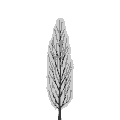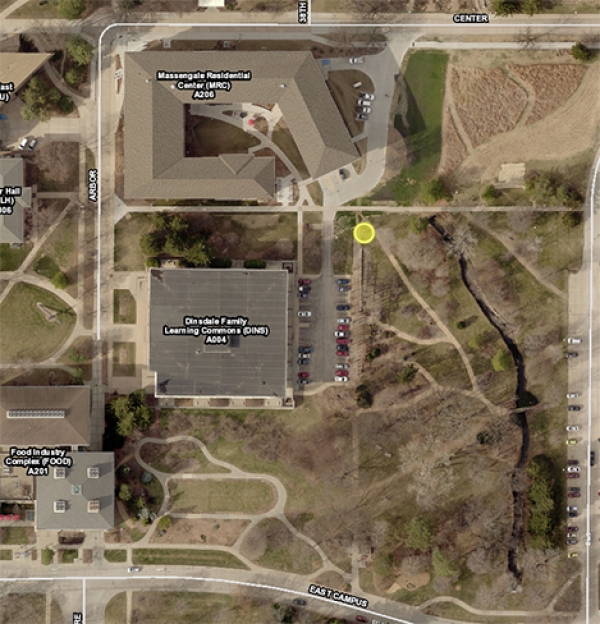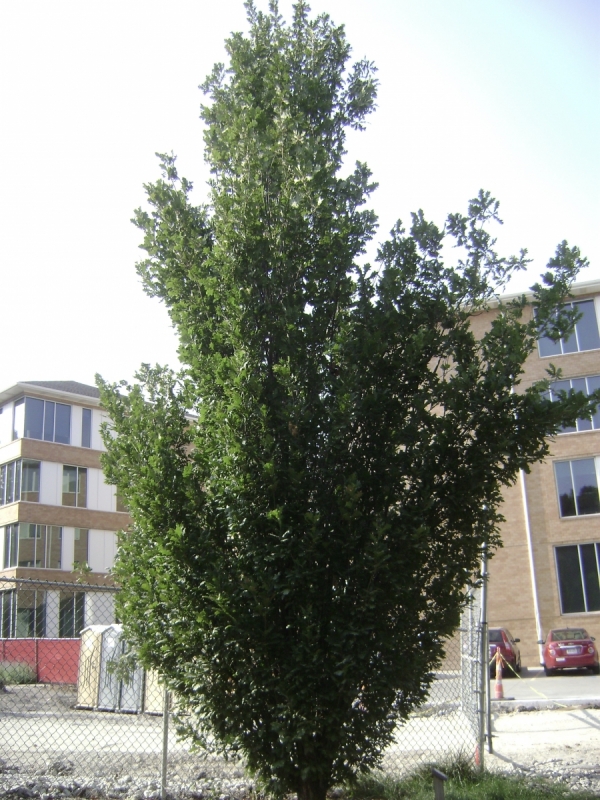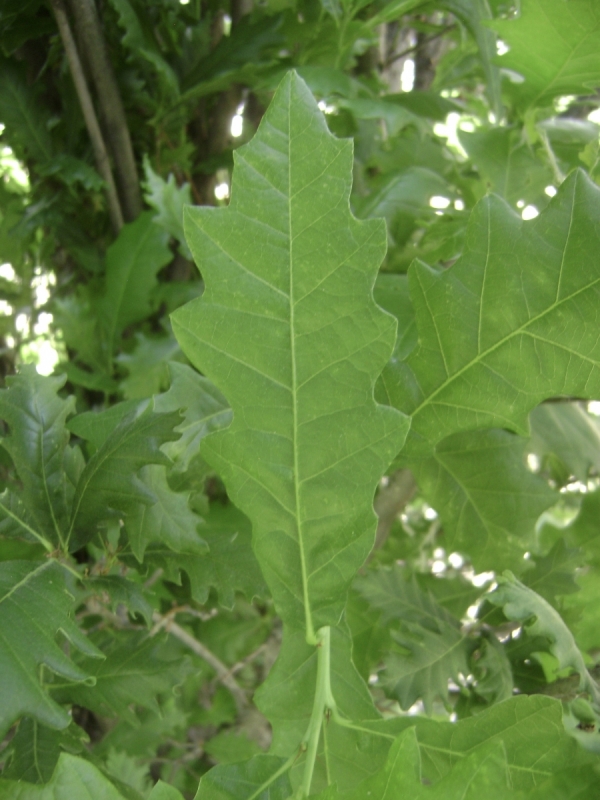
About Oaks (home) | Map | Plant List | Cultivar/Species Information | Sources | Other Campus Oaks of Interest
Latin Name: Quercus robur × alba 'JFS-KW2QRX'
Common Name: Skinny Genes® English × White Oak

Cultivar: 'JFS-KW2QRX', sold as Skinny Genes®
Family: Fagaceae
Division: White
Range:
Introduced: Plant Patent: PP24,442; 2012, J. Frank Schmidt & Son, Co.
Sun/Shade: sun
Height: 45' × 10'
Form: dense ascending branching, a tightly fastigiate habit, narrowly columnar
Zones: to Zone 4
Flower:
Leaves: From the patent: glossy, very dark green. Smooth on upper surface, mostly smooth below. Sheen.--Moderately glossy. Length.--11 cm to 16 cm when measured on two year old trees. Width.--5 cm to 8 cm when measured on two year old trees. Petioles.--5 mm to 9 mm long by 2 mm in diameter. Overall shape.--Obovate with five to eight pairs of lobes. The sinuses between the lobes generally extend one-third to one-half of the distance to the mid-rib. Leaf orientation.--Strongly upward. Margin.--Lobed with acute to slightly rounded lobe tips. Tip.--Acute. Base.--Auriculate. Stipules.--None. Veination.--Pinnate.
Fall Color: yellow, not great; marcescent into late fall and early winter.
Fruit: Acorn
Buds:
Bark: Grayish. Strongly furrowed with numerous deep vertical furrows and a moderate number of horizontal furrows that create square plates.
Wildlife:
Disease issues: Powdery mildew resistant
Cultural Uses:
Folklore:
Where to find Quercus robur × alba 'JFS-KW2QRX' :
"In 1991, I planted together in a row, seven upright and mostly narrow growing oaks of the of the species Quercus robur and hybrids of Quercus robur f. fastigiata.times.alba. Among these was an experimental selection that had been identified as Quercus robur.times.alba #7 (not patented). In the fall of 1996, I noticed that Quercus robur.times.alba #7 produced a crop of acorns. I collected these acorns and sowed them in a nursery seedbed in Boring, Oreg. They germinated in the spring of 1997. I grew these seedlings for two years in the seedbed and then planted a group of these seedlings in April, 1999, in a nursery row to grow for evaluation and possible selection. I subsequently selected a small group of 12 of these seedlings for further evaluation and transplanted them into a nursery row having wider spacing in February of 2002. The remaining seedlings not selected for the small group were destroyed. I evaluated these 12 selected trees during 2002 and 2003. In the fall of 2003, I selected `JFS-KW2QX` as superior in appearance based on foliage qualities, narrow fastigiate form, and resistance to powdery mildew. In February 2004, I transplanted `JFS-KW2QX` to a long term evaluation block. Of the other eleven trees, all were destroyed except one tree, named `KW-7QRX` (not patented) that was kept for further evaluation. `KW-7QRX` has a broadly oval form that is very different from `JFS-KW2QX`, and is believed to have a different pollen parent. The seed parent tree Quercus robur.times.alba #7 was destroyed in 2001 after determining that it was susceptible to powdery mildew and its form was broader, somewhat open, and not as desirable as `JFS-KW2QX`.
I began trial asexual propagation of small plots of `JFS-KW2QX` trees. I commenced this asexual propagation in August 2003 by successfully chip budding six trees onto Quercus robur rootstock. In 2004 I asexually propagated nine trees, in 2005 I asexually propagated seven trees, in 2006 I asexually propagated nine trees, in 2007 I asexually propagated 17 trees, and in 2008 I asexually propagated two trees. All propagation was done in nursery field rows in Canby, Oreg. by chip budding onto Quercus robur (not patented) rootstock. In each case, trees were grown for two or three years in nursery rows along side other oak varieties and observed and evaluated regularly. The trees that were asexually propagated in 2006 were transplanted in 2010 to another location in the Canby, Oreg. nursery. All of the other test trees were destroyed. From asexually propagated trees of my new variety, I established that my new variety possesses a unique combination of characteristics of fast first year growth, dense branching, a tightly fastigiate growth habit, and a narrowly columnar shape with deeply colored summer foliage and powdery mildew resistance and that these characteristics are firmly fixed in each successive generation."
←Previous Oak → NEXT OAK
All images from Maxwell Arboretum unless noted Form, 2020
Form, 2020Foliage
